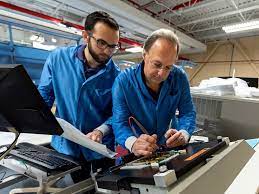In today’s rapidly evolving industrial landscape, efficiency and speed are paramount. UV curing systems have emerged as game-changers, offering innovative solutions to expedite manufacturing processes while ensuring high-quality results. In this blog, we’ll delve into the world of UV curing systems, exploring their functionality, applications, and the transformative impact they have on various industries.
Understanding UV Curing Systems:
UV curing systems utilize ultraviolet (UV) light to initiate a photochemical reaction that quickly cures coatings, adhesives, and inks. These systems consist of UV lamps that emit high-intensity UV light, along with associated equipment such as conveyors, reflectors, and control systems to optimize the curing process.
How UV Curing Works:
- Initiation: When UV light from the lamp strikes the photosensitive material (coating, adhesive, or ink), it initiates a polymerization reaction.
- Crosslinking: The molecules in the material undergo crosslinking, forming strong bonds and transforming from a liquid or semi-liquid state to a solid state.
- Curing: As the material passes under the UV lamp, it undergoes rapid curing, achieving full hardness and durability within seconds.
Applications of UV Curing Systems:
- Printing Industry: UV curing is widely used in offset, flexographic, and digital printing for quick drying of inks, varnishes, and coatings on various substrates like paper, plastic, and metal.
- Coatings and Finishes: UV curing systems are employed in the automotive, furniture, and electronics industries for applying clear coats, sealants, and decorative finishes with superior durability and scratch resistance.
- Adhesive Bonding: UV-curable adhesives offer fast bonding of substrates in industries such as electronics, medical devices, and automotive assembly, eliminating the need for solvent-based adhesives and enabling automation.
- Optical Fiber Manufacturing: UV curing is integral to the production of optical fibers, where it facilitates the polymerization of acrylate coatings, ensuring high-performance fiber optic cables.
- Woodworking and Flooring: UV curing systems are utilized in the woodworking industry for curing UV coatings on wood surfaces, including furniture, cabinetry, and flooring, resulting in enhanced durability and a smooth finish.
Advantages of UV Curing Systems:
- Speed: UV curing offers rapid curing times, significantly reducing production cycle times and increasing throughput.
- Energy Efficiency: UV curing systems consume less energy compared to traditional thermal curing methods, leading to lower operating costs and reduced environmental impact.
- Quality: UV-cured materials exhibit superior hardness, chemical resistance, and color stability, resulting in high-quality finished products.
- Versatility: UV curing can be applied to a wide range of substrates, including heat-sensitive materials like plastics and thin films.
- Safety: UV curing systems incorporate safety features such as shielding and interlocks to protect operators from UV radiation exposure.
